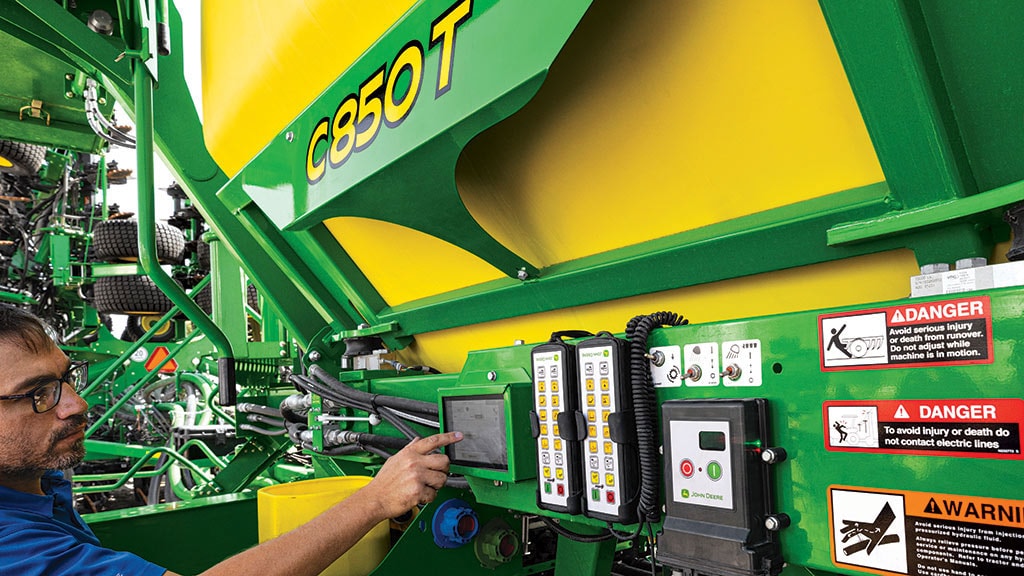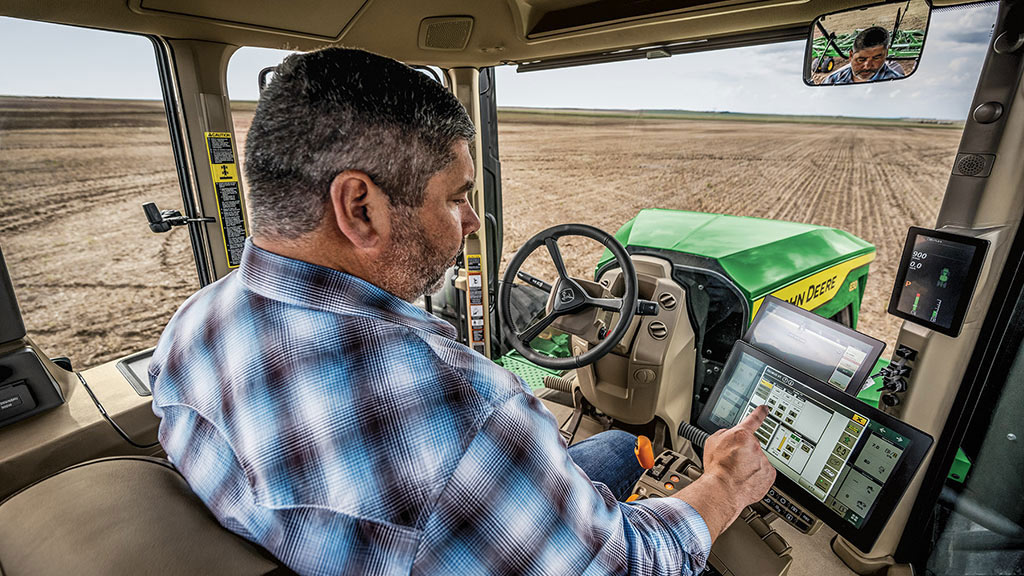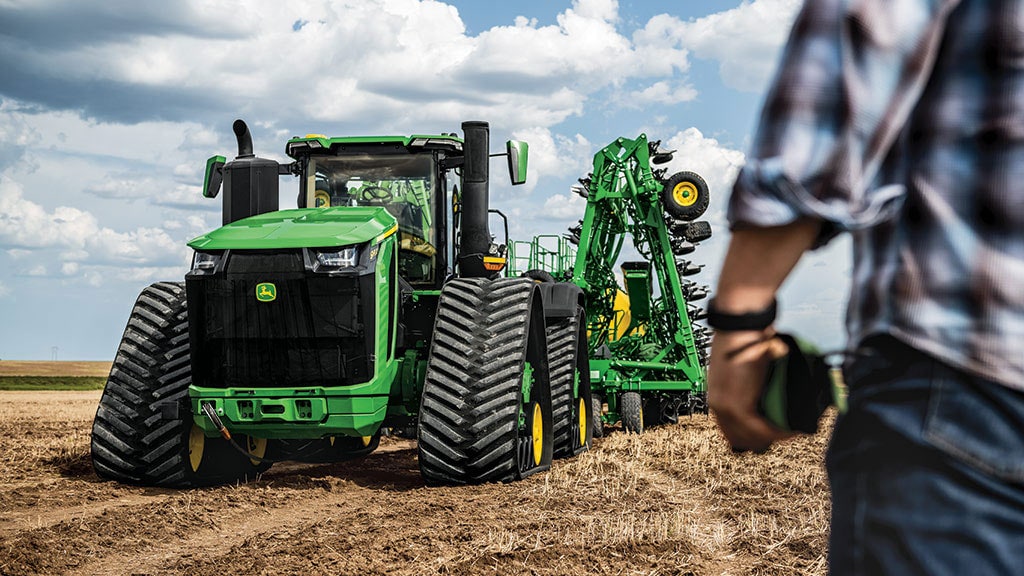

Full Seed Ahead
When time's short and there's plenty of ground to cover, know you can seed with confidence. John Deere offers a complete line of everything you need—in the sizes you want—to seed for success. From air drills and air carts to fertilizer attachments and box drills, that all includes the precision ag technology to help you maximize your productivity so you can seed smart with accuracy you can measure.
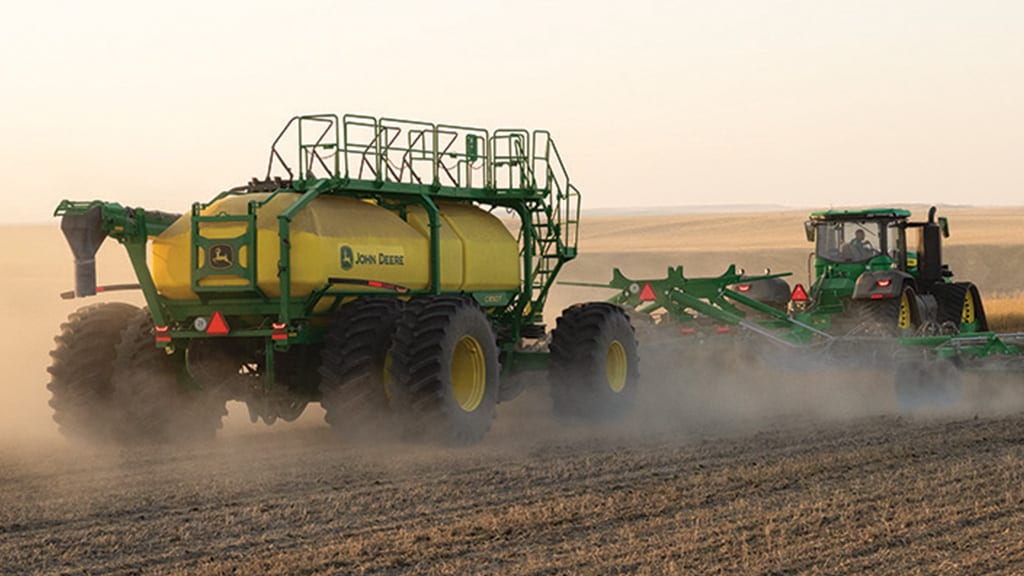
The New John Deere C-Series Air Carts
Simple. Concise. Innovative.
- Seed up to eight times1 more precisely with the new AccuRate™ stainless steel electric meters
- Industry-exclusive EZCal™ system that saves time and steps by sending calibration numbers automatically to the cab display
- Calibrate from the cab with ActiveCal and improve seeding confidence and productivity with tank scales
- Fully integrated, intelligent plug-and-play seeding solution
Tour the new C850T Air Cart
Take a closer look at key features of the C-Series Air Carts that will help you seed with confidence, and take a walk around the new 9RX 830, the perfect match for the C850T Air Cart.
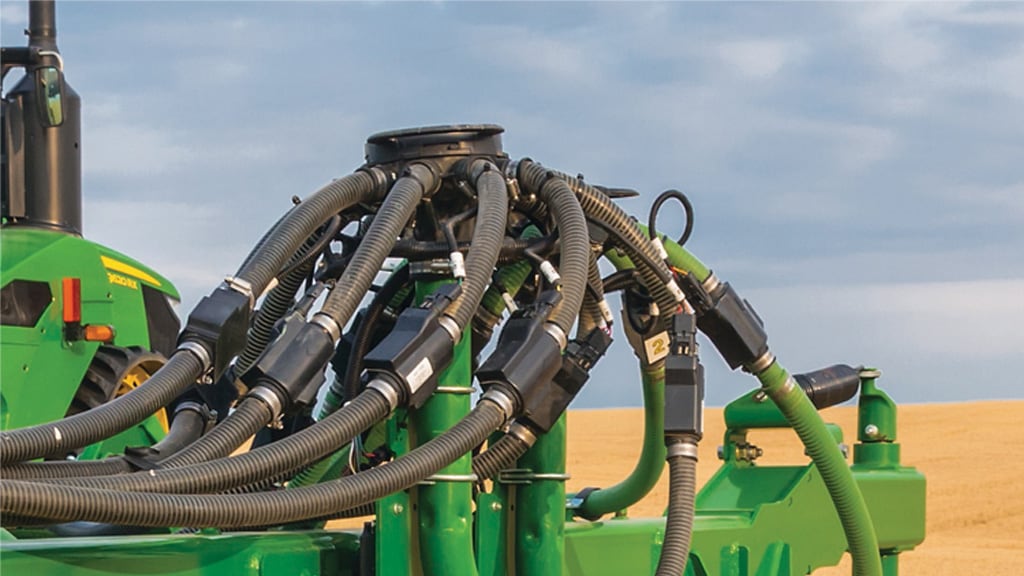
RelativeFlow™ Blockage Sensors
Enjoy peace of mind knowing seed is being distributed accurately. RelativeFlow™ Blockage Sensors help ensure uniform distribution, and are now available on all air seeding tools.
- Get alerts when blockages or reductions occur.
- Avoid the hassles and costs of reseeding because of run blockages, or retaining seed and fertilizer.
- Save time by not having to leave the tractor to check for blockages.
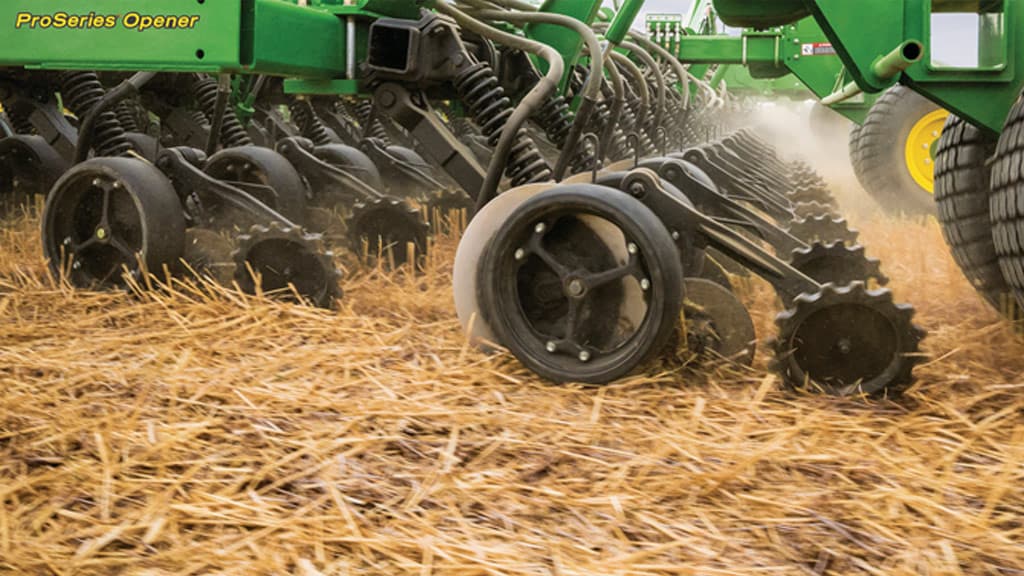
Quick Change Blade (ProSeries™ Enhancement)
Change blades faster to save time, and reduce labour costs. Quick Change Blades are available on all no-till air seeding tools.
- Replace blades easily before, during, or after seeding season.
- Reduce change time by up to 45%1.
- Minimize labour needed for manual blade changes.
1Compared to Pro Series openers installed on MY21 and prior models. Based on internal John Deere testing. Individual results may vary.
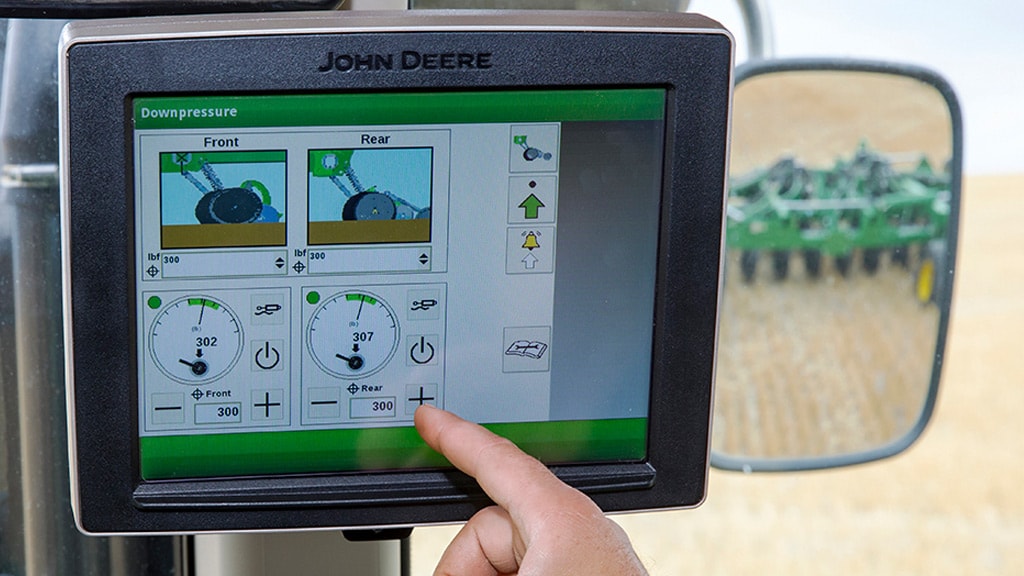
TruSet™ In-Cab Downforce
Be confident in your seed and fertilizer placement as you control downforce without ever having to leave the cab. You can view and adjust downforce settings on your generation 4 display.
- Improve seed-to-soil contact.
- Achieve uniform emergence across varying soil conditions.
- Reduce downtime by not leaving the cab to adjust downforce manually.
ProSeries™ Opener Aftermarket Parts
Improve seed-to-soil contact, depth consistency, germination and uniform emergence with ProSeries™ Opener
Go from good to great with the ProSeries™ Opener Aftermarket Parts from John Deere. Upgrade your 90 Series Opener with six state-of-the-art parts to improve seed-to-soil contact, depth consistency, germination and uniform emergence.
Seeding Technology
TruSet™ Technology
Adjust depth and down-pressure in seconds from your cab
RelativeFlow Blockage Software
Spot potential problems before they occur
Compare Our C-Series Air Carts
| Model | Capacity | Pull Type |
|---|---|---|
|
12.3 cu m (350 bu.) |
Leading |
|
|
14.1 cu m (400 bu.) |
Leading |
|
|
17.6 cu m (500 bu.) |
Leading |
|
|
19.4 cu m (550 bu.) |
Leading |
|
|
22.9 cu m (650 bu.) |
Leading |
| Model | Capacity | Pull Type |
|---|---|---|
|
12.3 cu m (350 bu.) |
Trailing |
|
|
14.1 cu m (400 bu.) |
Trailing |
|
|
17.6 cu m (500 bu.) |
Trailing |
|
|
19.4 cu m (550 bu.) |
Trailing |
|
|
22.9 cu m (650 bu.) |
Trailing |
|
|
29.9 cu m (850 bu.) |
Trailing |
Compare our Air Drills
| Model | Working Width | Transport Width | Fertilizer Placement | Opener | Row Spacing |
|---|---|---|---|---|---|
|
40 ft., 41 ft. 8 in. |
20 ft. |
In Furrow |
Ground-engaging knife |
7.5 in. (19.05-cm) |
|
|
50 ft., 50 ft. 7.5 in. |
20 ft. |
In Furrow |
Ground-engaging knife |
7.5 in. (19.05-cm) |
|
|
59 ft. 4 in., 61 ft. 7 in., 62 ft. 3 in |
20 ft. |
In Furrow |
Ground-engaging knife |
7.5 in. (19.05-cm) |
|
|
41 ft. 8 in., 50 ft. 8 in. |
20 ft. |
Separate |
Ground-engaging knife |
10-in. (25.4-cm) |
|
|
41 ft. 8 in., 50 ft. 8 in. |
20 ft. |
Separate |
Ground-engaging knife |
10-in. (25.4-cm) |
|
|
58 ft. 4 in., 60 ft. |
20 ft. |
Separate |
Ground-engaging knife |
10-in. (25.4-cm) |
|
|
30 ft. |
14 ft. 4 in., 18 ft. 4 in. |
In Furrow |
New ProSeries™ |
7.5-in. (19.05-cm) |
|
|
36 ft. |
14 ft. 4 in., 18 ft. 4 in., |
In Furrow |
New ProSeries™ |
7.5-in. (19.05-cm) |
|
|
40 ft. |
14 ft. 4 in., 18 ft. 4 in., |
In Furrow |
New ProSeries™ |
7.5-in. (19.05-cm) |
|
|
42 ft. |
14 ft. 4 in., 18 ft. 4 in., |
In Furrow |
New ProSeries™ |
7.5-in. (19.05-cm) |
|
|
50 ft. |
14 ft. 4 in., 18 ft. 4 in., |
In Furrow |
New ProSeries™ |
7.5-in. (19.05-cm) |
|
|
60 ft. |
14 ft. 4 in., 18 ft. 4 in., |
In Furrow |
New ProSeries™ |
7.5-in. (19.05-cm) |
|
|
30 ft. |
14 ft. 4 in., 18 ft. 4 in. |
Separate |
New ProSeries™ |
10-in. (25.4-cm) |
|
|
40 ft. |
14 ft. 4 in., 18 ft. 4 in. |
Separate |
New ProSeries™ |
10-in. (254-mm) |
|
|
43 ft. |
14 ft. 4 in., 18 ft. 4 in. |
Separate |
New ProSeries™ |
10-in. (25.4-cm) |
|
|
60 ft. |
14 ft. 4 in., 18 ft. 4 in. |
Separate |
New ProSeries™ |
10-in. (25.4-cm) |
|
|
40 ft. |
19 ft., 22.6 ft |
In Furrow |
Air Hoe Drill |
9-in. (23-cm) paired row |
|
|
56 ft. |
19 ft., 22.6 ft |
In Furrow |
Air Hoe Drill |
9-in. (23-cm) paired row |
|
|
28 ft., 36 ft., 44 ft. |
16 ft. 3 in., 19 ft. |
In Furrow |
Double-disk openers |
6 in. (15-cm) |
|
|
60ft. |
20 ft. 8 in. |
Separate |
Ground engaging dual knife |
10-in. (25.4 cm) 12-in. (30.48 cm) |
|
|
70 ft. |
19 ft. 10 in. |
Separate |
Ground-engaging dual knife |
10-in. (25.4 cm) 12-in. (30.48 cm) |
|
|
80 ft. |
25 ft. 4 in. |
Separate |
Ground-engaging dual knife |
12-in. (30.48 cm) |
|
|
90 ft. |
25 ft. 9 in. |
Separate |
Ground-engaging dual knife |
12-in. (30.48 cm) |
*Models and widths may not be available at the time of publication. Please see your John Deere dealer for details.
Compare our Integrated Tank Air Drills
The 1990 CCS™ is now the N500C Series (Including the N530C, N536C, N540C and N542C): N – no-till opener. 5 – Series. 30 – width. C – Central Commodity System.
| Model | Working Width | Capacity | Spacing | Opener |
|---|---|---|---|---|
|
30 ft. |
100 bu., 120 bu. |
7.5 in., 10 in., 15 in., 20 in. |
ProSeries™ |
|
|
36ft. |
100 bu., 120 bu. |
7.5 in., 10 in., 15 in., 20 in. |
ProSeries™ |
|
|
40ft. |
100 bu., 120 bu. |
7.5 in., 10 in., 15 in., 20 in. |
ProSeries™ |
|
|
42ft. |
100 bu., 120 bu. |
7.5 in., 10 in., 15 in., 20 in. |
ProSeries™ |
Compare our Box Drills
| Model | Working Width | Grain Box Capacity | Grain/Fertilizer Box Capacity |
|---|---|---|---|
|
25 ft., 30 ft., 35 ft. |
70 bu. (2.8 bu./ft.), |
85 bu. (3.4 bu./ft.), |
|
|
10 ft., 15 ft., 20 ft. |
3.5 bu./ft. |
1.4 bu./ft., 2 bu./ft. |
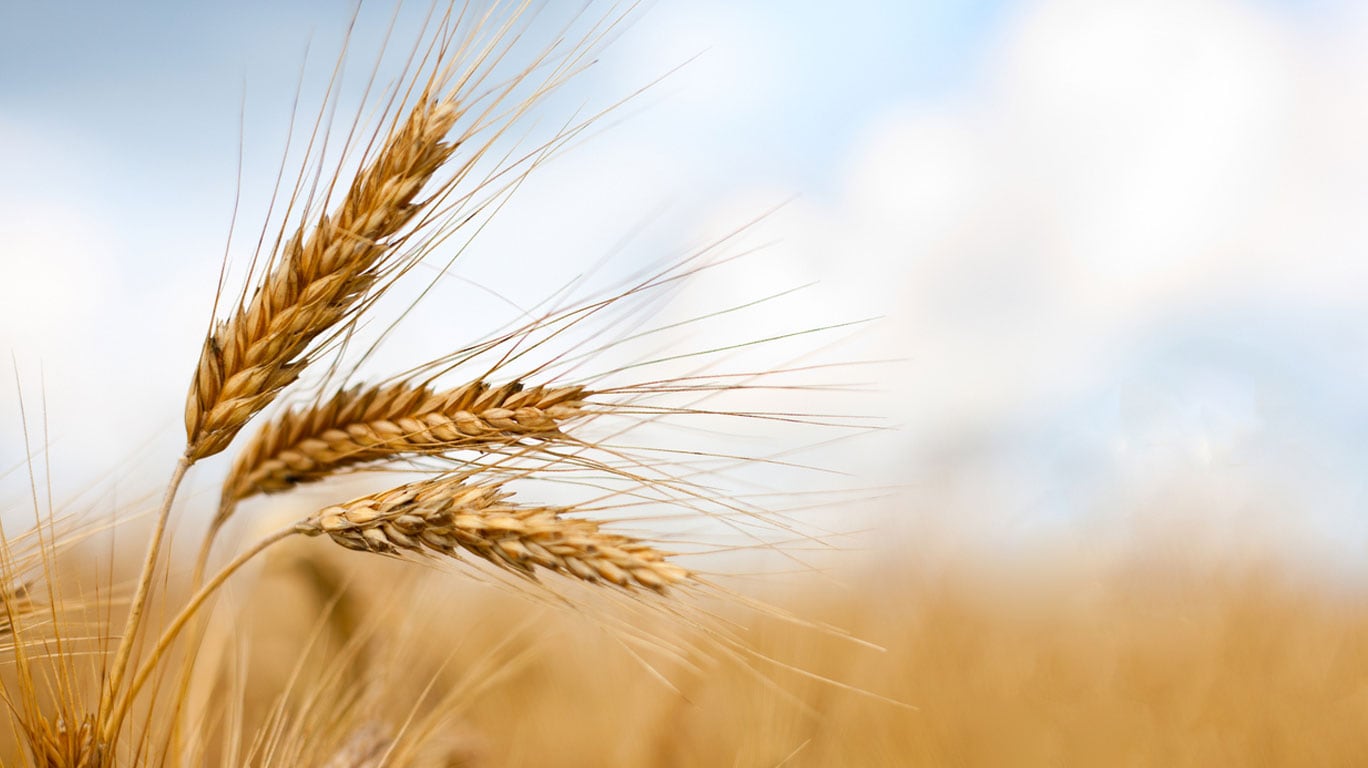
Farm Even Better
Maximize the full potential of your field.
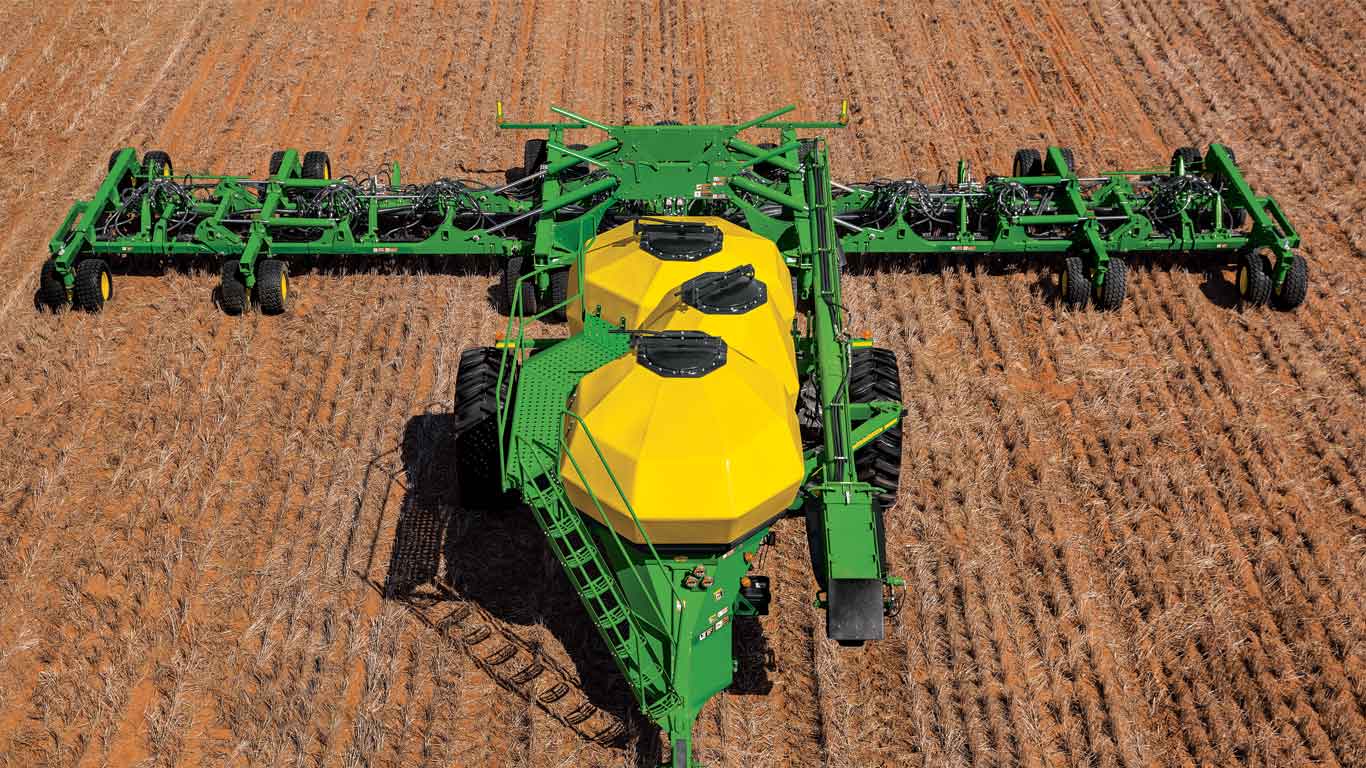
Build Your Own
Build and price seeding equipment to fit your needs.
Introducing the Tips Notebook
A compilation of tips, ideas and collective wisdom about how to get all kinds of jobs done around your place. This is where you’ll find the how-do-I-do-that answers you’re looking for, all in one place. It’s loaded with easy-to-understand instructions, videos, and links to product information.
Compare End-Wheel Grain Drills
An easy, mid-priced way to seed into conventional tillage.
· 8 to 13 ft. (2.5 to 4.0 m) working widths
· Drill cereal grains, legumes and forage crops
· Standard hydraulic lift cylinder raises and lowers the openers
· Optional combination seed/fertilizer box available
| Model | Working Width | PTO HP | Hitch |
|---|---|---|---|
|
8 ft. (2.4 m) Wide, 7.5 in. (19.1 cm) row spacing |
42 hp (31.3 kW) minimum |
Pull-Type |
|
|
10 ft. 6 in. (3.2 m) Wide, 6 & 7.5 in. (15.2 & 19.1 cm) row spacings |
42 hp (31.3 kW) minimum |
Pull-Type |
|
|
13 ft. (4.0 m) Wide, 6 & 7.5 in. (15.2, 19.1 cm) row spacings |
42 hp (31.3 kW) minimum |
Pull-Type |
Compare Frontier™ Conservation Seeders
Renovate pastures or landscape roadsides with a Conservation Seeder. It makes quick work of any type of seeding, from native prairie grasses to large legumes.
· Work at speeds up to 11.2 km/h
· Full-width coverage to prevent "pinstripe" effect
· Reinforced nylon or cast-iron rear cultipacker rings
· Includes various combinations of standard large-grain, native grass, small-seed legume, and stainless-steel fertilizer boxes
· iMatch™ and Quick-Coupler compatible (iMatch™ compatible CS1360 only)
| Model | Working Width | PTO HP | Hitch |
|---|---|---|---|
|
5 ft. (1.5 m) |
30 hp (22.4 kW) minimum |
Cat. 1 and 2 |
|
|
7 ft. (2.1 m) |
50 hp (37.3 kW) minimum |
Cat. 1 and 2 |
Compare Frontier™ Overseeders
Get the lush, green turf you demand with a Frontier Overseeder that allows placement of grass seed without reworking your lawn.
· High-precision metering seed cups
· Flow adjustment chart and lever
· iMatch™ compatible
| Model | PTO Driven | Working Width | PTO HP | Hitch |
|---|---|---|---|---|
|
Ground Driven |
48 in. (1.22 m) |
Minimum 15 hp (11.2 kW) |
Limited Category 1 |
|
|
Ground Driven |
60 in. (1.52 m) |
Minimum 45 hp (22.3 kW) |
Limited Category 1 |
|
|
Ground Driven |
48 in. (1.22m) |
Minimum 30 hp (22.3 kW) |
Cat. 1 and Cat. 2 |
|
|
Ground Driven |
60 in. (1.52 m) |
Minimum 35 hp (26.1 kW) |
Cat. 1 and Cat. 2 |
|
|
Ground Driven |
72 in. (1.83 m) |
Minimum 50 hp (37.3 kW) |
Cat. 1 and Cat. 2 |
|
|
Ground Driven |
84 in. (2.13 m) |
Minimum 55 hp (41 kW) |
Cat. 1 and Cat. 2 |
|
|
PTO Driven |
58 in. (147.3 cm) |
25 – 45 hp (18.6 – 33.6 kW) |
Cat. 1 |
Compare Frontier™ Broadcast Spreaders
Cover a lot of ground in a hurry with a Broadcast Spreader. These spreaders distribute seed, lime, or fertilizer in an area up to 49 ft. (14.9 m) wide.
· Wide variety of sizes from 3.5 to 10.6 cu. ft. (0.1 to 0.3 m3)
· Non-corrosive polyethylene seamless hopper (SS20 and SS30 Series only)
· Two pull-type models available (SS1022B and SS1035B)
· Optional weather cover and remote gate control (SS10 and SS20 Series only)
| Model | Working Width | PTO HP | Hitch |
|---|---|---|---|
|
20 ft. (6.1 m) swath |
16 - 30 hp (11.9 - 22.4 kW) |
Pull-Type |
|
|
23 ft. (7.0 m) swath |
16 - 30 hp (11.9 - 22.4 kW) |
Cat. 0 and 1 |
|
|
20 ft. (6.1 m) swath |
16 - 45 hp (11.9 - 33.6 kW) |
Pull-Type |
|
|
23 ft. (7.0 m) swath |
16 - 45 hp (11.9 - 33.6 kW) |
Cat. 1 |
|
|
46 ft. (14.0 m) swath |
16 - 55 hp (11.9 - 41.0 kW) |
Cat. 1 |
|
|
23 ft. (7.0 m) swath |
16 - 45 hp (11.9 - 33.6 kW) |
Cat. 1 |
|
|
46 ft. (14.0 m) swath |
16 - 55 hp (11.9 - 41.0 kW) |
Cat. 1 |
|
|
49 ft. (14.9 m) swath |
20 - 60 hp (14.9 - 44.7 kW) |
Cat. 1 |
Compare Frontier™ Pendular Spreaders
A precision Pendular Spreader provides uniform spreading, even if materials have different weights, sizes, and textures.
· Broad range of sizes, from 9.0 to 42.4 cu. ft. (0.25 to 1.20 m3)
· Durable reinforced fiberglass hopper
· Optional hydraulic control and sand/salt spout
| Model | Working Width | PTO HP | Hitch |
|---|---|---|---|
|
47 ft. (14.3 m) swath |
20 - 60 hp (14.9 - 44.7 kW) |
Cat. 1 |
|
|
47 ft. (14.3 m) swath |
20 - 60 hp (14.9 - 44.7 kW) |
Cat. 1 and 2 |
|
|
47 ft. (14.3 m) swath |
20 - 60 hp (14.9 - 44.7 kW) |
Cat. 1 and 2 |
|
|
47 ft. (14.3 m) swath |
20 - 60 hp (14.9 - 44.7 kW) |
Cat. 1 and 2 |
Additional Resources
Shop and Buy
You May Also Be Interested In
1Based on seeding with an 8 primary run air cart and a 24 meter (80-foot) air seeder. Prescription zones would improve from 24 meter (80-foot) zones to 3 meter (10-foot) zones.
